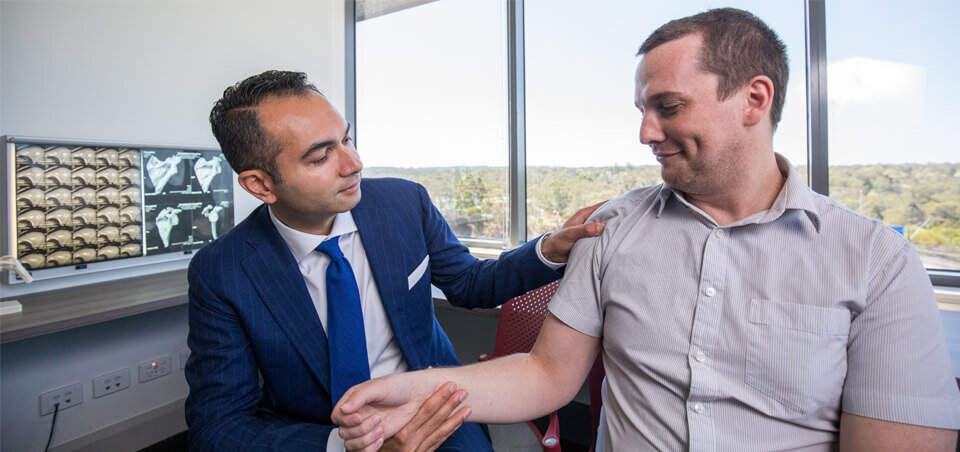Pectoralis Major Tendon Rupture
Knowledge that empowers
What is it?
The pectoralis major is a large and powerful muscle that originates on the front of the chest wall (clavicle, sternum and ribs) and extends to its insertion on the humerus where it forms a thick tendon.
This pectoralis major internally rotates, adducts and flexes the arm and is extremely important for movements such as a push-up or bench press.
A pectoralis major tendon rupture refers to a tearing injury of the tendon. A common mechanism for this injury is lowering a heavy barbell when performing a bench press. Tears of this tendon are often categorised as partial or complete and may be further classified by which part of the tendon or muscle is torn such as the musculotendinous junction, muscle belly or tendinous insertion to the humerus.

Who is affected?
Pectoralis major tendon ruptures are most commonly seen in weight lifters.
However, these injuries can occur in athletes who participate in other sports and recreational activities that require substantial force production from the pectoralis major such as martial arts and water skiing.
This injury is typically seen in males between the age of 20-40. You are more likely to tear this tendon if you have had a previous injury to the pectoralis major tendon, are a smoker, have taken extended courses of corticosteroid medications or used anabolic steroids. For the latter group it is common to be torn at the mio-tendinous junction or the muscle
What are the symptoms?
When the pectoralis major tendon is torn, there is often a popping or tearing sensation felt at the front of the shoulder or chest.
This may initially be quite painful however this pain normally subsides over the course of a few days or perhaps even a week or so. The chest and upper arm often become very swollen and a bruise appears by gravity reaching sometimes the elbow.
As the pain and swelling subsides, the most noticeable symptom of a pectoralis major tendon rupture is a feeling of weakness or fatigue, particularly in those movements that the pectoralis major is responsible for.
How is the diagnosis made?
Pectoralis major tendon rupture is normally detected by physical examination of the shoulder. A visible deformity at the axillary fold may be present when the pectoralis muscle is forced to contract.
Diagnostic imaging of the pectoralis muscle isn’t entirely necessary to confirm this injury; however, it is particularly important to help plan for surgical repair of the tendon. Your doctor or surgeon will likely refer you to have an ultrasound or MRI.
What is the prognosis?
Following pectoralis major tendon rupture, reattachment of the tendon to the bone is not possible without surgery. It is therefore very important to consult with your general practitioner so that they can refer you for an opinion from a Shoulder and Elbow Surgeon.
Non surgical treatment
Immediately after the injury, it is important to manage pain and swelling with rest or immobilisation in a sling if necessary.
Non-steroidal anti-inflammatory medications may also be helpful however we recommend that these should only be taken under instruction from your doctor or pharmacist.
Should surgery not be possible, or should someone opt for non-surgical management, the injured person may experience weakness of the arm, cramping or spasms of the pectoralis muscle.
The cosmetic appearance of chest deformity may also be bothersome with a depression at the axillary fold and subsequent atrophy of the Pectoralis muscle. A physiotherapist can help guide a return to physical activity and prescribe strengthening exercises for the uninjured muscles of the forearm and elbow that assist in flexion and supination of the forearm.
Although it is not all that common, it is possible to partially tear the pectoralis major tendon. In cases of a partial tear, a physiotherapist can help by developing an individualised rehabilitation program to reduce pain and swelling, and assist in guiding a graded return to work or manual labour.
Surgical treatment
It is generally accepted that surgical repair of a ruptured pectoralis major tendon is the optimal management to restore the normal function of the pectoralis major muscle.
Surgical repair of a pectoralis major tendon involves reattachment of the tendon to its bony insertion. This open procedure is done through an incision in the front of the shoulder.
The outcomes of surgical repair for pectoralis major tendon ruptures are, in most cases, excellent. That being said, strict adherence to the post-surgical rehabilitation program is vital to reduce the risk of re-rupture. This process can take approximately 6 months and usually involves:
- Protecting the repair in a sling for the first 6 weeks after surgery
- Range of motion exercises to restore normal motion to the shoulder
- Commencement of a strengthening program at 3 months after surgery
